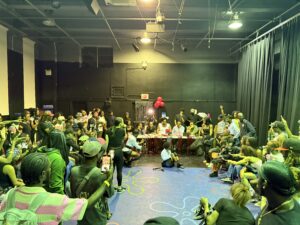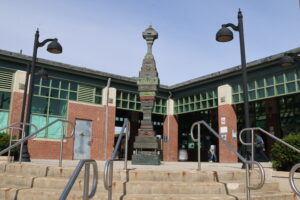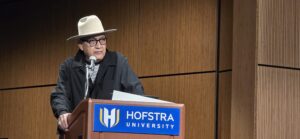By Emma Prashad
A routine Sewanhaka Central High School District Board of Education meeting grew tense recently when a parent voiced concerns about Pride and transgender flags displayed in her daughter’s classroom. The comments sparked an exchange that highlighted broader questions about inclusion, neutrality and what symbols should be displayed in public schools.
Christine O’Neill, whose daughter began ninth grade at Floral Park Memorial High School in September, told the board she was distraught when her child showed her a photo of the classroom.
“In school, everyone is supposed to feel comfortable,” O’Neill said. “That kind of ideology should be private, in someone’s home, not in the classroom.” She argued the American flag alone should serve as the symbol of unity. “If someone comes from Italy, I don’t put up an Italian flag to make them feel welcome,” she said. “The American flag is for everybody.”
Board President William Leder responded that the display was not ideological but rather a gesture of welcome. “I don’t think a flag is an ideology,” Leder said. “It’s a way to let people know that everyone is welcome. I have a rainbow flag outside my own home for that reason.”
Another parent later stood to share an opposing view. She said she did not identify as LGBTQ herself, but believed that symbols of inclusion mattered, especially given the history of discrimination in the U.S.
“Having a flag in the room is not saying, ‘This is what I want for you,’” she said. “It is merely saying, ‘I don’t hate you for it. I will not shun you for this.’”
She noted that marginalized groups have faced laws and cultural barriers that excluded them from full participation in American life. “We’ve had laws in this country to persecute these people,” she said. “We’ve had individuals saying they can’t work, they can’t marry. So this is about being inclusive, not promoting anything.”
O’Neill, however, stood by her position, saying the flag still made her and her daughter feel unwelcome. “In school, it should be mutual. Everybody should feel included,” she said, adding that she was considering moving her daughter into another class.
The conversation did not end with the parents. After the meeting, three student board representatives discussed the issue further as they left the building. When approached for comment by The Advocate, all three supported keeping pride flags in classrooms.
Christopher Seeber, a Carey High School junior, said representation is about safety and visibility. “People deserve to feel safe, no matter where they are,” he said. “As long as it’s not harming anybody, and it isn’t, having something that makes students feel seen and heard is so important.”
Kyara Ozil, a Sewanhaka High School junior and the board’s ex-officio student member, said O’Neill’s comments overlooked the wider student body. “As a parent, your instinct is to protect your child,” she said. “But what about other people’s children? Especially teenagers who have been victims because of who they are? We need to look out for everyone in the community.”
Jasmine Chen, a Floral Park Memorial junior, echoed those thoughts. “It represents minorities who have been ostracized, especially the LGBTQ community,” she said. “Having that flag up doesn’t promote an ideology — it just means all students are welcome, no matter what background you are from.”








